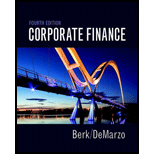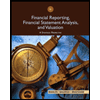
a)
To discuss: Whether the statement is inconsistent with an
Introduction:
Capital asset pricing model (CAPM) describes the relationship between the projected return for assets and systematic risk on the stocks. It is utilized to compute the required
b)
To discuss: Whether the statement is inconsistent with an efficient capital market, the capital asset pricing model (CAPM), or both.
Introduction:
Beta is an important indicator of the risk of a security. It measures the systematic risk of a risky investment by comparing the risky investment with the average risky asset in the market.
c)
To discuss: Whether the statement is inconsistent with an efficient capital market, the capital asset pricing model (CAPM), or both.
Want to see the full answer?
Check out a sample textbook solution
Chapter 10 Solutions
Corporate Finance (4th Edition) (Pearson Series in Finance) - Standalone book
- A firm needs to raise $950,000 but will incur flotation costs of 5%. How much will it pay in flotation costs? Multiple choice question. $55,500 $50,000 $47,500 $55,000arrow_forwardWhile determining the appropriate discount rate, if a firm uses a weighted average cost of capital that is unique to a particular project, it is using the Blank______. Multiple choice question. pure play approach economic value added method subjective approach security market line approacharrow_forwardWhen a company's interest payment Blank______, the company's tax bill Blank______. Multiple choice question. stays the same; increases decreases; decreases increases; decreases increases; increasesarrow_forward
- For the calculation of equity weights, the Blank______ value is used. Multiple choice question. historical average book marketarrow_forwardA firm needs to raise $950,000 but will incur flotation costs of 5%. How much will it pay in flotation costs? Multiple choice question. $50,000 $55,000 $55,500 $47,500arrow_forwardQuestion Mode Multiple Choice Question The issuance costs of new securities are referred to as Blank______ costs. Multiple choice question. exorbitant flotation sunk reparationarrow_forward
- What will happen to a company's tax bill if interest expense is deducted? Multiple choice question. The company's tax bill will increase. The company's tax bill will decrease. The company's tax bill will not be affected. The company's tax bill for the next year will be affected.arrow_forwardThe total market value of a firm is calculated as Blank______. Multiple choice question. the number of shares times the average price the number of shares times the future price the number of shares times the share price the number of shares times the issue pricearrow_forwardAccording the to the Blank______ approach for project evaluation, all proposed projects are placed into several risk categories. Multiple choice question. pure play divisional WACC subjectivearrow_forward
- To invest in a project, a company needs $50 million. Given its flotation costs of 7%, how much does the company need to raise? Multiple choice question. $53.76 million $46.50 million $50.00 million $53.50 millionarrow_forwardWhile determining the appropriate discount rate, if a firm uses a weighted average cost of capital that is unique to a particular project, it is using the Blank______. Multiple choice question. economic value added method pure play approach subjective approach security market line approacharrow_forwardWhat are flotation costs? Multiple choice question. They are the costs incurred to issue new securities in the market. They are the costs incurred to insure the payment due to bondholders. They are the costs incurred to meet day to day expenses. They are the costs incurred to keep a project in the business.arrow_forward
 Intermediate Financial Management (MindTap Course...FinanceISBN:9781337395083Author:Eugene F. Brigham, Phillip R. DavesPublisher:Cengage Learning
Intermediate Financial Management (MindTap Course...FinanceISBN:9781337395083Author:Eugene F. Brigham, Phillip R. DavesPublisher:Cengage Learning
 Financial Reporting, Financial Statement Analysis...FinanceISBN:9781285190907Author:James M. Wahlen, Stephen P. Baginski, Mark BradshawPublisher:Cengage Learning
Financial Reporting, Financial Statement Analysis...FinanceISBN:9781285190907Author:James M. Wahlen, Stephen P. Baginski, Mark BradshawPublisher:Cengage Learning



